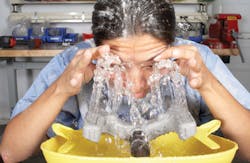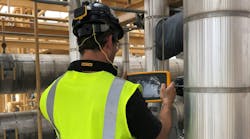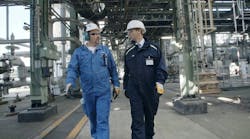Once every six seconds, someone suffers injury that requires medical attention, says the National Safety Council. For the eyes alone, the Centers for Disease Control reports, each day about 2,000 U.S. workers are victim of a job-related eye injury requiring medical treatment. Processing-industry facilities house hazardous and corrosive materials and chemicals that pose serious exposure and injury hazards to workers and especially to their eyes. Exposure can be minimized by personal protection equipment (PPE), but plumbed emergency equipment is the next line of defense. Employees should have immediate access to emergency showers — whether eye/face washes, drench showers, combination units, enclosed safety showers or other — equipped to remove harmful substances from affected employees.
Even then, one final detail shouldn’t be neglected. Emergency showers must immediately and reliably access tepid water. In fact, the American National Safety Institute (ANSI) requires it.
An often unheeded rule
ANSI Z358.1-2009 requires tepid flushing fluid — between 60 degrees F and 100 degrees F — for all types of emergency equipment applications. Tepid water is defined as flushing fluid at a temperature conducive to encouraging an injured party to complete the full 15-minute flush during an emergency.
The ANSI requirement for tepid water has been in place since 1998, but is not always heeded. Some mistakenly think that cold water will be sufficient for eye wash or drench shower fixtures. But if water is too cold or too hot, users won’t undergo the full procedure. If below 60 F, prolonged exposure increases hypothermia risk. If over 100 F, hot water could lead to chemical interaction with eyes and skin, or cause scalding.
In emergencies, processing plants must dependably deliver — on-demand — unlimited tepid water so as to promote complete wash downs for chemicals removal.
Enough water must be supplied also to support the full 15-minute flushing-fluid flow. For both drench showers and eyewashes, a minimum water pressure of 30 pounds per square inch (PSI) should be supplied to the unit. The ANSI minimum flow rate is at least 20 gallons per minute (gpm) for drench showers, 0.4 gpm for eyewashes and 3.0 gpm for eye and face washes. Actual flow rates vary and many fixtures exceed the minimum, but verify with the equipment manufacturer. Combination fixtures require simultaneous use of both the drench shower and eye wash.
Equipment provision
Tankless water heaters and thermostatic mixing valves (TMVs) are used in supplying tepid water. Consider the following when selecting a system:
Electric tankless water heaters provide an unlimited supply of tepid water. Latest models draw energy only when needed, reach the ANSI tepid-water temperature standards in 20 to 30 seconds, hold outlet temperature to within ± 1 degree F, and have a low pressure drop.
For many models, pressure drop is less than five pounds per square inch, minimizing any post-installation complications that could be caused by sudden pressure decrease.
Some newer water heaters have redundant safety and anti-scald features to meet ANSI tepid water requirements. Overshoot purge protection automatically expels excess hot water whenever necessary.
Today’s tankless water heaters draw energy only when needed. Besides energy savings, installation entails only one electrical connection and a cold water line. Tankless water heaters have many other uses, including the following:
- Boosting water temperature
- Wash down of parts and vehicles
- Equipment sterilization
- Laboratory testing
- Chemical process heating
No matter the application, right-sizing tankless water heaters depends on flow rate, temperature rise, power supply and other factors. When calculating temperature rise, assume the annual coldest ground-water temperature.
A mix of hot & cold
With thermo-static mixing valves, hot and cold water is brought into the valve where it is mixed together and then routed over a thermostat, used to maintain the temperature of the mixed water flow. If temperature deviates from setpoint, the inlet ports modulate flow until set point is re-attained.
TMVs used should be specified for supply of tepid water to emergency fixtures. Those meant for use with emergency fixtures will have a cold water bypass. Should the thermostat fail or the hot water source be lost for any reason, cold water would still flow through the valve to the emergency fixture. If the cold supply is lost, the valve will shut off and prevent hot water from flowing to the emergency fixture. A hot flushing fluid cannot be supplied to the eyewash or shower.
Consulting with a third-party safety consultant or emergency-equipment manufacturer helps determine what type of emergency equipment and heating mechanism is best for the situation at hand. When dealing with the health, safety and well-being of employees, appropriate and fail-safe emergency fixtures and water-delivery system ensures proper usage, confidence and peace-of-mind.
Common production hazards that require a 15-minute flush
- Dust, dirt, salt, sand, cardboard, wood, chips, powder and fine particulate
- Nails, wood slivers and staples
- Metal shavings, filings, dust, concrete and cement chips
- Smoke, flammable or poisonous gases
- Insecticides, pesticides, herbicides and fumigants
- Solvents, stains, paint, thinner and acetone
- Blood borne pathogens:; blood, bodily fluids and remains
- Caustic water treatment chemicals
- Gas, diesel, cleaning solvents and antifreeze
- Laboratory chemicals and oxygen
- Bleach, chlorine and ammonia
- Battery acid, starter fluid, paints, oils and hydraulic fluid
- Bacteria, germs and biohazards
- Falling, flying or shifting debris such as rocks, building materials and glass
- Thermal hazards, UV radiation burns (welder’s flash) and electrical arcs
- Acids, bases, solvents and lime
- Flammable liquids
Jason M. Renner is senior product manager for Keltech, a subsidiary of Bradley Corp.,
Bradley Corp. of Menomonee Falls, Wisconsin, makes locker room products, plumbing fixtures, partitions, emergency fixtures and tankless water heaters.


